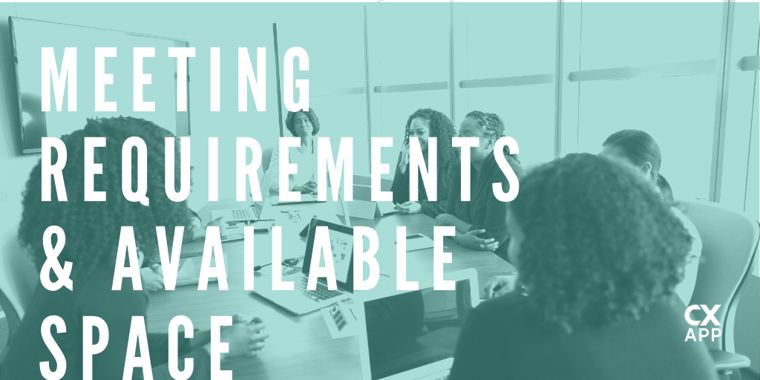Conference Room Attributes Help Efficient Space Usage In The Workplace
August 11, 2020 CXAI Team
As companies grow to be more agile over time, workspaces need to become more flexible. There are several reasons for this, but none more important than the fact that the efficient management of work stations and shared spaces should always be a top priority.
A workspace is a hot commodity that must be used adequately. However, most organizations underutilize space or simply do not understand the value of its proper management. An eye-opening 73% of meetings involve just two to four people, yet 53% of conference-room space is designed to accommodate meetings of seven or more.
Even worse, 40% of employees reveal they waste half an hour per day looking for meeting spaces. It's time that should be going to more productive, high-value tasks.
Booking a Room the Right Way
The process of booking a conference room must be put under a microscope, to ensure it's being handled in the most optimized way. It should go smoothly not just for employees making a reservation, but also everyone included. A real-time and online booking system can alert others, allowing everyone to see which shared spaces are going to be occupied and for how long.
For that to happen, the foundational software platform must be data-driven and smart enough to deliver the necessary details. The result is a workforce that can make informed decisions about how they use and reserve spaces on company property.
Moreover, every space or conference room has a distinct set of attributes and amenities, and by sharing that information via booking software, it furthers informed decision-making. Meeting planners can choose spaces based on unique requirements such as the number of seats, potential media tools, additional furniture, and other amenities like a coffee pot or wet bar.
Mobile booking applications are one of the best solutions, but there are many ways to implement the technology.
Workspace Attributes and Amenities Matter
A large part of managing spaces in the workplace deals with the layout and attributes of a particular space, not just how large or how many seats are in the room. The additional attributes matter and requirements will change depending on what type of meeting or event is being conducted. A formal interview or review, for example, is going to be a lot less inviting than a company day-party, in regards to how space is used. The party will need an open space with a wet bar, communal seating, and more. The interview space doesn't need as much room, with only a few seating options in a close-knit arrangement.

Effective meeting management calls for a fine-tuned selection, or rather the booking of a space that matches its purpose. Here are just a few popular attributes that not only matter but should be visible within reservation software and conference room booking tools:
- The total number of seats in a room versus the occupancy level
- The room layout and intended function
- Views and scenery, including external windows
- Climate controls and current temperature settings
- Additional furniture like chairs, couches, collaboration pods
- Amenities like wet bars, stocked fridges, coffee machines, game consoles, extra screens, etc.
- Projectors and connected sound systems for presentations
- A video or audio conference system with remote access (conference room relay)
- Bathroom access
Of course, these are just some of the examples that may or may not be important. It depends on the sizeand function of the space, as well as how it's been designed. Some of the best conference room technology augments a space, not by changing how it's used, but merely improving its intended purpose. A projector and sound system in a presentation room, for example, make such events more entertaining and engaging.
Benefits Of Live Maps and Room Availability
The option to virtually reserve conference rooms and similar meeting spaces offers vast implications for the future of the workplace. The boons are even greater when mobile connectivity is included as part of the deal, allowing workers to remotely book and research individual work or meeting spaces. Realistically, there should be workstation and desk booking software available, too in order to accommodate a flexible workplace.
Any existing space is utilized more efficiently, cutting down on wasted areas. Most importantly, administrators and space management professionals can see, at any given time, what spaces are being used and which are being overlooked. The software allows for real-time tracking solutions, which even help to properly manage capacities — a feature critical in today's social-distanced climate.
Meetings or collaborations also tend to become more purpose-driven, matching the space to the needs of the event. There's less time wasted on spatial planning, at least for those conducting the meetings. It also significantly streamlines end-to-end meeting services, eliminating mistakes like needing to relocate because a room doesn't meet the requirements.
Overall, group event planning and meeting execution are enhanced through a simple, yet effective virtual system. Imagine being able to see, in a single application, what spaces are available, how many people each room can accommodate, and what they offer in terms of amenities and tools?
Real-Time Updates and Always-On Accessibility
Conference rooms impact every role and every department in an organization. Going a step further, they even impact external roles for board members, partners, customers, and more. The meeting spaces must be built with practicality in mind. It's wasteful to use an expansive room, designed for large crowds, to facilitate a two-person meeting.
Rooms must match the audience, the purpose, and the general goal. It's common sense, yet something that seems to be sorely lacking.
65% of professionals indicated that half or more of the huddle spaces they use need video conferencing abilities, yet don't have them. 61% report half or more huddle spaces need a digital whiteboard. Unfortunately, only 11% of IT pros have full visibility into the utilization of these huddle spaces.
The problem is two-fold. Not only do the rooms need to be optimized and practical, but relevant metrics must be available for all — including details about a particular space's amenities. These rooms must be able to match the needs of the audience, and the only way to make that happen is an accessible, always-on virtual platform.

.png)

.png)

-1.png?width=450&height=250&name=Smart%20Campus%20App%20(1)-1.png)




